Introduction
In 2017, the Security Council held 296 meetings, adopted 61 resolutions and issued 27 presidential statements. It considered 52 agenda items, dispatched five missions to the field, three to Africa and two to the Americas, and established a new sanctions regime in connection with the situation in Mali.
Concerning its subsidiary bodies, the Council decided to establish the United Nations Verification Mission in Colombia, which succeeded the United Nations Mission in Colombia, established in 2016. The Council also extended the mandate of the United Nations Stabilization Mission in Haiti (MINUSTAH) for a final period of six months, and decided to establish a follow-on peacekeeping mission, namely, the United Nations Mission for Justice Support in Haiti (MINUJUSTH). In addition, the United Nations Operation in Côte d’Ivoire (UNOCI) completed its mandate on 30 June 2017.
On 30 August 2017, the Council issued presidential note (S/2017/507) which superseded and further developed previous notes on the working methods of the Council, outlining recent practices and newly agreed measures.
MEETINGS

UN Photo/Manuel EliasSecurity Council considers the Reports of the Secretary-General on the Sudan and South Sudan (15 May 2017)
Meetings of the Security Council are governed by Article 28 of the Charter of the United Nations, and rules 1-5 and 48 of its provisional rules of procedure. Under its current practice, the Council convenes meetings, which are classified as either public or private. Council members also frequently meet in informal consultations of the whole (also known as consultations).
Overview
In 2017, the Security Council held 296 meetings: 282 public meetings and 14 private meetings. With the exception of one meeting on the agenda item titled “Briefing by the President of the International Court of Justice”, all other private meetings were with troop- and police-contributing countries (TCCs/PCCs). In addition to the 137 consultations held during 2017, the Council had substantive briefings and/or discussions under “Other matters” (also known as “Any Other Business” (AOB)), on 39 occasions.
Chart 1(a): Number of meetings and consultations: 2013-2017
Chart 1(b): Number of meetings and consultations: 2013-2017
Meetings and consultations
In 2017, the Council held, on average, 24.7 meetings and 11.4 consultations per month. June was the month with the most meetings held (a total of 40), while January, February and June reached the maximum number of consultations held per month (with a total of 14 each).
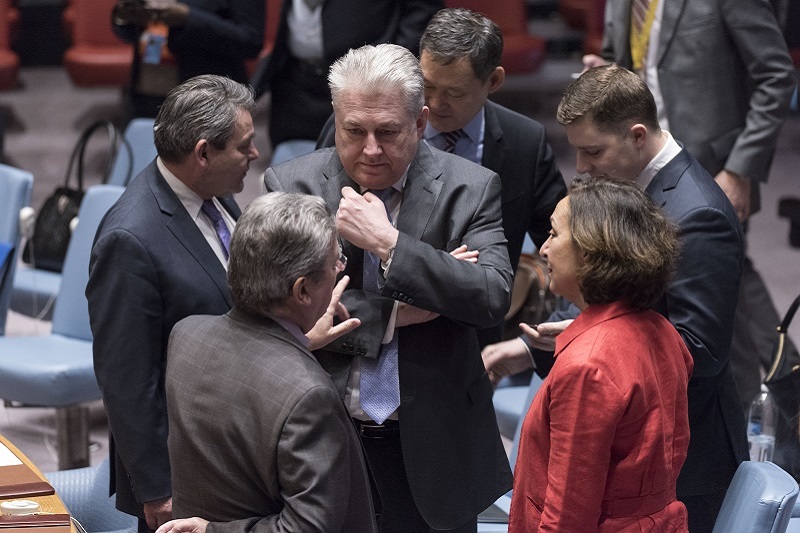
UN Photo/Mark GartenSecurity Council meets to consider the situation in Middle East, Including the Palestinian Question (16 February 2017)
Chart 2: Number of meetings and consultations by month in 2017
* “Other matters” refers to the substantive briefings and/or discussions under “Other matters” (also known as “Any Other Business” (AOB)) during consultations.
High-level meetings
19
In 2017, the Council held 19 high-level meetings, in which two or more Council members were represented at ministerial level or above. [For details see Annex, Table I].
Chart 3: Number of high-level meetings: 2013-2017
Representatives on the Council
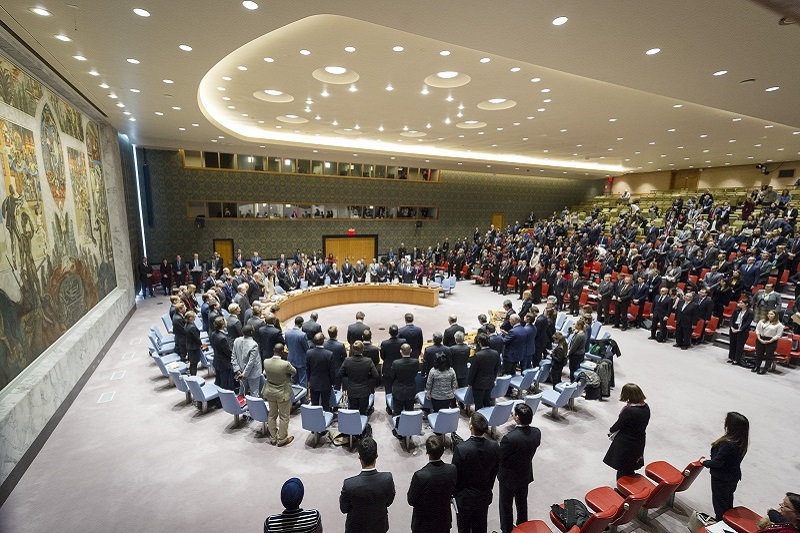
UN Photo/Rick BajornasSecurity Council pays tribute to Vitaly I. Churkin, Permanent Representative of the Russian Federation to the UN, who passed away on 20 February (21 February 2017)
According to Article 28 of the Charter of the United Nations, each member of the Security Council shall be represented at all times at the seat of the Organization. Rule 13 of the Provisional Rules of Procedure provides further that each member of the Security Council shall be represented at the meetings of the Security Council by an accredited representative. While all Council members have one Permanent Representative (for a total of 15), some Council members may appoint more than one Deputy-Permanent Representative to the Council. In 2017, the number of women Permanent and Deputy-Permanent Representatives on the Council was six, while the number of men Permanent and Deputy-Permanent Representatives was 31.
Chart 4(a): Permanent (PR) Representatives on the Council for the period 2013-2017
Chart 4(b): Deputy-Permanent (DPR) Representatives on the Council for the period 2013-2017
Invitations under rule 39 of the Provisional Rules of Procedure
According to rule 39 of the Security Council Provisional Rules of Procedure, the Council may invite members of the Secretariat or other persons, whom it considers competent for the purpose, to supply it with information or to give other assistance in examining matters within its competence. In 2017, the Council invited a total of 340 speakers under rule 39, of which 258 were men and 82 were women. In addition, out of the 340 invitees, 234 were officials belonging to the UN System, 59 were officials representing regional intergovernmental organizations, 17 were invitees from international organizations other than the UN, while 30 invitees were representatives of other entities such as non-governmental organizations.
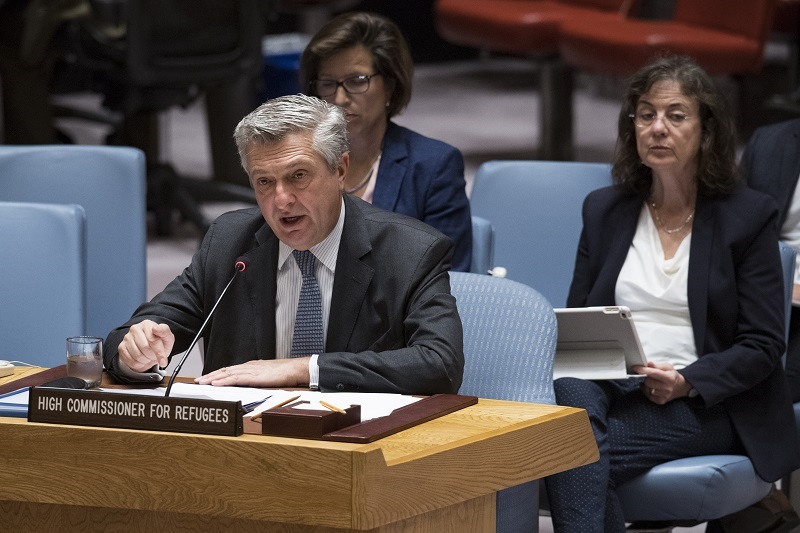
UN Photo/Manuel EliasUN High Commissioner for Refugees briefs the Security Council (2 November 2017)
Chart 5(a): Invitees under rule 39 for the period 2013-2017
* The category “UN system” includes officials of the African Union-United Nations Hybrid Operation in Darfur (UNAMID).
Chart 5(b): Invitees under rule 39 for the period 2013-2017
Informal consultations of the whole
In 2017, Council members held 137 consultations on a variety of topics. Further to scheduled consultations, other topics were raised under the item “Other matters” leading to substantive briefings and/or substantive discussions in 39 instances. The most discussed topics in consultations during 2017 were: (i) Syria (33 times); (ii) Sudan/South Sudan (19 times); and (iii) Middle East, including the Palestinian question (ten times). Below is an infographic of topics discussed at least three times in consultations during 2017.
Figure 1: Frequency of topics discussed in informal consultations of the whole in 2017
Video tele-conferences
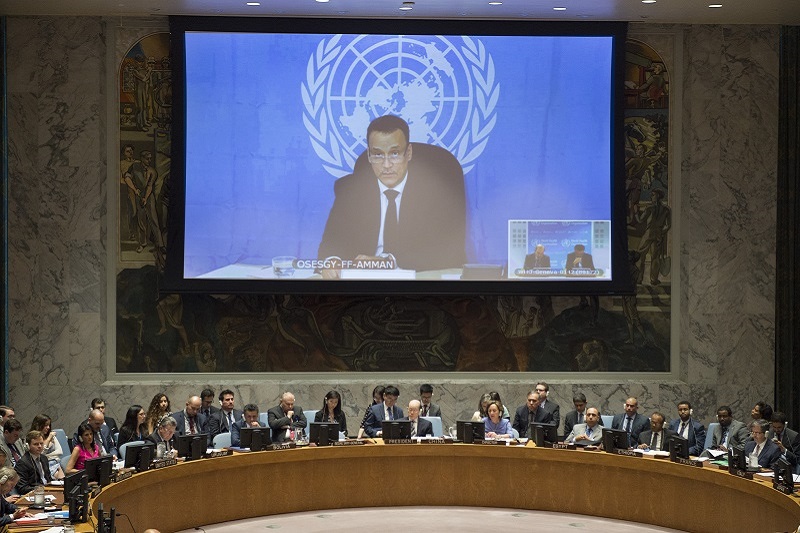
UN Photo/Eskinder DebebeSecretary-General's Special Envoy for Yemen briefs the Security Council via video conference (12 July 2017)
The Council continued to use video tele-conferencing (VTC) for meetings and consultations, a practice that has become increasingly prevalent since its introduction in 2009. In 2017, the Council was briefed by VTC 73 times.
Chart 6: Use of video tele-conferencing: 2013-2017
Informal interactive dialogues
7
In 2017, the practice of holding informal interactive dialogues (IID) continued. IIDs, also known as informal interactive discussions, are chaired by the President of the Council and are intended to allow Council members to informally exchange views with interested parties on specific topics. In 2017, the Council held seven IIDs covering matters relating to country-specific situations, namely the Sudan and South Sudan, the Central African Republic, Libya and Haiti, as well as thematic issues concerning the cooperation with regional organizations and peacebuilding. [For details see Annex, Table II].
Chart 7: Number of informal interactive dialogues: 2013-2017
Arria-formula meetings
17
Arria-formula meetings are convened by Council members as flexible and informal forums to enhance their deliberations. In 2017, the Council held 17 Arria-formula meetings covering a broad range of issues, both country-specific and thematic. On 31 March, the Council held an Arria-formula meeting under the title “Hybrid wars as a threat to international peace and security”. This was the first time that Council members and the wider United Nations membership specifically discussed hybrid warfare. [For details see Annex, Table III]
Chart 8: Number of Arria-formula meetings: 2013-2017
MISSIONS
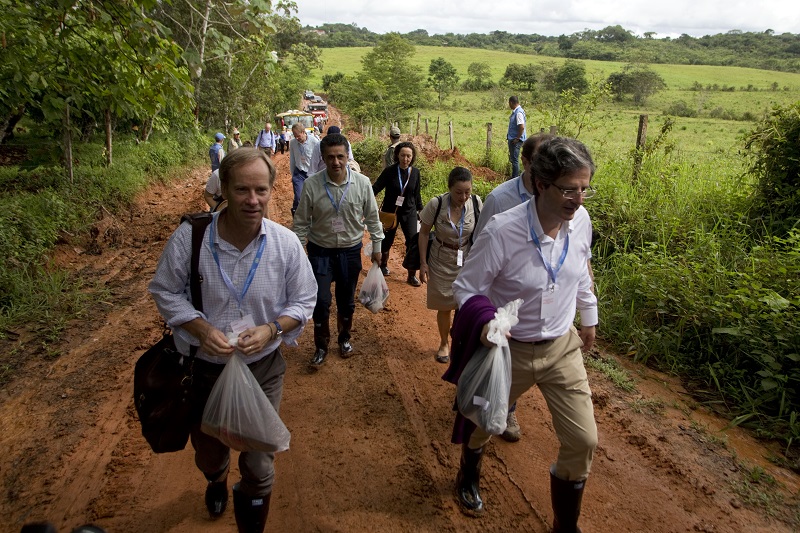
UN Photo/Juan M. BarreroSecurity Council visits Colombia (5 May 2017)
Article 34 of the Charter of the United Nations provides that the Security Council may investigate any dispute or any situation which may lead to international friction or give rise to a dispute. Missions of Council members to the field have taken place since 1964.Furthermore, in presidential note of 30 August 2017 on working methods of the Council (S/2017/507), the Council underlined the value of its missions in order to understand and assess particular conflicts or situations on the agenda of the Council.
Missions in 2017
In 2017, five Security Council missions were dispatched. From 1 to 7 March, the Council sent a mission to the countries of the Lake Chad basin region – Cameroon, Chad, the Niger and Nigeria, co-led by France, Senegal and the United Kingdom. From 3 to 5 May, the Council went on a mission to Colombia, co-led by United Kingdom and Uruguay. From 22 to 24 June, the Council visited Haiti on a mission headed by the Plurinational State of Bolivia. From 6 to 8 September, Ethiopia led a mission of the Council to the African Union (AU), in Addis Ababa, Ethiopia. Finally, from 19 to 22 October, the Council visited the Sahel region, namely Burkina Faso, Mali, Mauritania, on a mission led by Ethiopia, Italy and France.
Africa
March 2017
| Mission to: | Co-Led By |
|---|---|
| Cameroon | France, Senegal and the United Kingdom |
| Chad | France, Senegal and the United Kingdom |
| the Niger | France, Senegal and the United Kingdom |
| Nigeria | France, Senegal and the United Kingdom |
Americas
May 2017
| Mission to: | Co-Led By |
|---|---|
| Colombia | United Kingdom and Uruguay |
| 1 | 1 |
Briefing on the Mission
Americas
June 2017
| Mission to: | Led By | |
|---|---|---|
| Republic of Haiti | The Plurinational State of Bolivia |
Africa
September 2017
| Mission to: | Led By |
|---|---|
| the African Union (AU) in Ethiopia | Ethiopia |
Africa
October 2017
| Mission to: | Co-Led By |
|---|---|
| Burkina Faso | Ethiopia, Italy, France |
| Mali | Ethiopia, Italy, France |
| Mauritania | Ethiopia, Italy, France |
Chart 9: Number of Security Council missions by region: 2013-2017
AGENDA
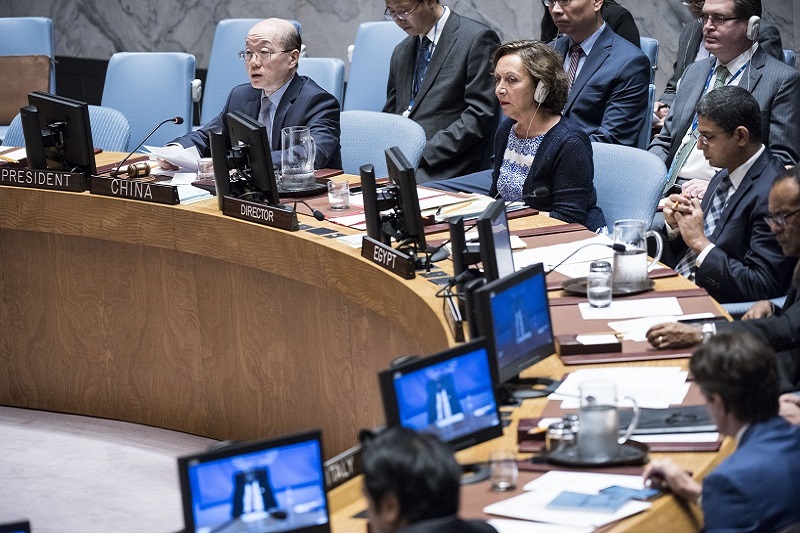
UN Photo/Kim Haughton
Security Council considers the Reports of the Secretary-General on the Sudan and South Sudan (20 July 2017)
In accordance with rule 11 of the provisional rules of procedure and presidential note S/2017/507, every January, the Council reviews the list of matters of which it is seized. Agenda items which have not been considered at a Council meeting in the preceding three years are deleted unless a Member State objects. In the latter case, an item will remain on the list for an additional year, and will be subject to the same procedure described above if not considered by the Council during that additional year.
Overview
In 2017, the Security Council considered a total of 52 agenda items. Out of the 52 agenda items, 28 addressed country-specific or regional situations and 24 thematic and other issues. [For details see Annex, Tables IV]. In addition, all items identified as subject to deletion in 2017 remained on the list of items of which the Security Council is seized, keeping the total number of agenda items on the list of the Council at 68.
Chart 10: Percentage of meetings on country-specific/regional situations and thematic and other issues in 2017
Chart 11: Number of meetings held and resolutions/PRSTs adopted by agenda item in 2017
* Under Security Council resolution 1244 (1999)
Country-specific and Regional Situations
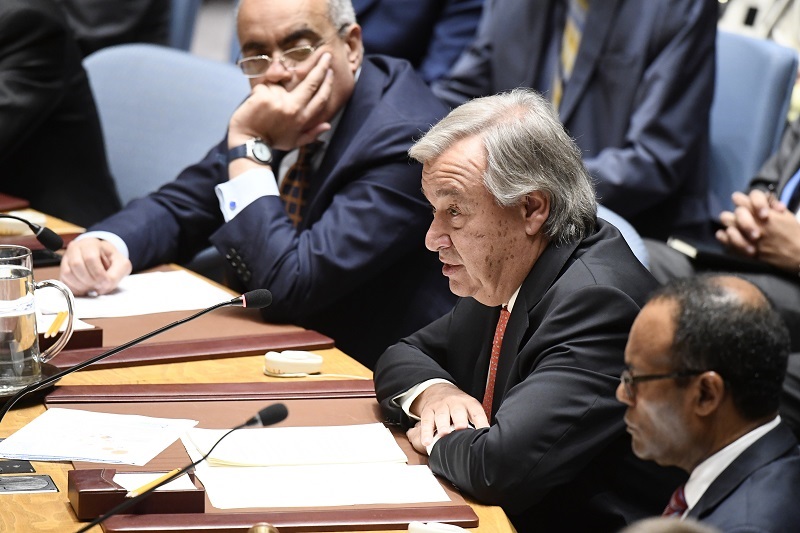
UN Photo/Evan Schneider
Security Council Considers the situation in Myanmar (28 September 2017)
In 2017, 69.3% (205) of the meetings of the Council dealt with country-specific or regional situations. Among those meetings, Africa accounted for 51.2% (105) of the meetings, followed by the Middle East with 28.3% (58), Asia with 9.8% (20), the Americas with 6.3% (13) and Europe with 4.4% (nine).
Chart 12: Percentage of meetings by geographic region in 2017
Thematic and Other Issues
In 2017, 30.7% (91) of Council meetings were held under agenda items of a thematic or cross-cutting nature. In addition, the Council continued the practice of conducting wrap-up sessions and did so at the end of the month in January, February, March, May, June, July, August, September, November and December. In February and August, under Ukrainian and Egyptian Presidencies respectively, wrap-up sessions were held as formal meetings of the Council under the item “Implementation of the Note by the President of the Security Council (S/2010/507)”. All other meetings took place as informal meetings of the Council. The informal sessions in January (Presidency of Sweden), May (Presidency of Uruguay), and June (Presidency of Bolivia), were held as “Toledo style informal wrap-up sessions” also known as “Toledo interactive briefings”. Toledo interactive briefings were launched in 2016, at the initiative of Spain, by members of the Council willing to present the activity of the Council for the month jointly, and in an interactive manner.
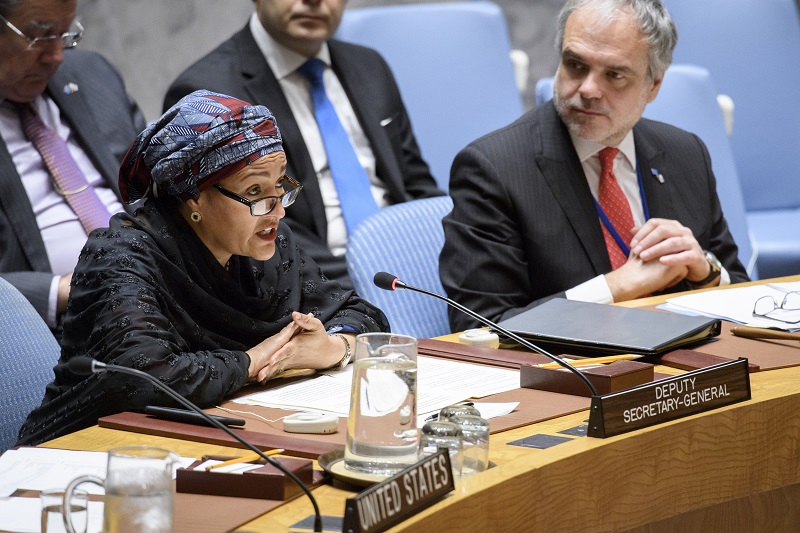
UN Photo/Manuel EliasSecurity Council debates sexual violence in conflict (15 May 2017)
DECISIONS AND VOTING

UN Photo/Evan SchneiderSecurity Council adopts resolution on the protection of cultural heritage (24 March 2017)
According to Article 27 of the Charter of the United Nations, each Council member has one vote. An affirmative vote of nine members is required for decisions to be adopted on procedural and substantive matters, including in the latter case the concurrent votes of the permanent members. In addition to procedural decisions related to the adoption of the agenda, extension of invitations and adjournment of meetings, the Council adopts resolutions and issues presidential statements. Council decisions also take the form of notes and letters by the President of the Council.
Overview
In 2017, the Security Council adopted a total of 61 resolutions and issued 27 presidential statements. The Council also issued nine notes, 39 letters by its President and 93 press statements.
Chart 13: Number of resolutions, presidential statements, notes and letters by the President: 2013-2017
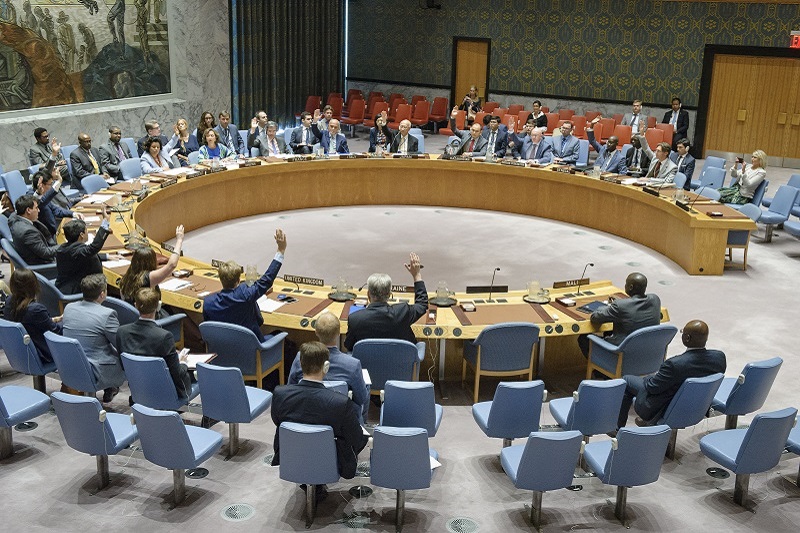
UN Photo/Manuel Elias
Security Council imposes sanctions in connection with the situation in Mali (5 September 2017)
Out of its 61 resolutions, 29 (47.5%) were explicitly adopted under Chapter VII of the Charter and 18 of the 29 resolutions (62.1%) concerned the region of Africa. The Council adopted for the first time resolutions regarding the following themes (i) the protection of critical infrastructure from terrorist attacks (resolution (2341 (2017)), (ii) stemming destruction, looting and smuggling of cultural heritage sites and artefacts (resolution (2347 (2017)), and (iii) mine action (resolution (2365 (2017)). By resolution 2339 (2017), in connection with the situation in the Central African Republic, the Council introduced, for the first time, sexual violence as a separate criterion for designating individuals or entities to be targeted with sanctions measures. In addition, by resolution 2374 (2017), the Council established a new sanctions regime with respect to the situation in Mali.
In 2017, 48 of the 61 resolutions and 22 of the 27 presidential statements concerned country or region-specific situations or conflicts; Africa accounted for 62.9% of those resolutions and presidential statements (44 in total), followed by Asia and the Middle East with 11.4% (eight) each, the Americas with 10% (seven), and Europe with 4.3% (three).
Chart 14: Percentage of decisions by geographic region in 2017
In 2017, the Council issued 93 press statements, of which 66.7% (62) concerned terrorist-related activities, attacks against civilians or attacks against United Nations personnel in the field. In 2017, 8.6% (eight) of the press statements related to nuclear non-proliferation. In addition, the most referenced countries or regions in press statements were: (i) Mali (12 times); (ii) Afghanistan (nine times); and (iii) the Democratic Republic of the Congo, and DPRK (eight times each).
Figure 2: Frequency of countries referred to in press statements in 2017
Voting
In 2017, out of 61 resolutions, 59 were adopted unanimously. In 2017, six vetoes were cast (see below). The vetoes were cast in relation to draft resolutions put to a vote in connection with the agenda item “The situation in the Middle East”, in the context of the conflict in the Syrian Arab Republic, and in connection with the agenda item “The situation in the Middle East, including the Palestinian question”. By comparison, two vetoes were cast during the year 2016.
Draft resolutions not adopted in 2017
| Draft resolution | Meeting | Date | Agenda | Votes in favour | Vote Against | Abstensions |
|---|---|---|---|---|---|---|
| S/2017/172 | 7893 | 28 February 2017 | The situation in the Middle East |
9 (France, Italy, Japan, Senegal, Sweden, Ukraine, United Kingdom, United States, and Uruguay) |
3 (Bolivia (Plurinational State of), China, and Russian Federation) |
3 (Egypt, Ethiopia, and Kazakhstan) |
| S/2017/315 | 7922 | 12 April 2017 |
10 (Egypt, France, Italy, Japan, Senegal, Sweden, Ukraine, United Kingdom, United States, and Uruguay) |
2 (Bolivia (Plurinational State of), and Russian Federation) |
3 (China, Ethiopia, and Kazakhstan) |
|
| S/2017/884 | 8073 | 24 October 2017 |
11 (Egypt, Ethiopia, France, Italy, Japan, Senegal, Sweden, Ukraine, United Kingdom, United States, and Uruguay) |
2 (Bolivia (Plurinational State of), and Russian Federation) |
2 (China, and Kazakhstan) |
|
| S/2017/962 | 8105 | 16 November 2017 |
11 (Ethiopia, France, Italy, Japan, Kazakhstan, Senegal, Sweden, Ukraine, United Kingdom , United States, and Uruguay) |
2 (Bolivia (Plurinational State of), and Russian Federation) |
2 (China, and Egypt) |
|
| S/2017/968 | 8105 | 16 November 2017 |
4 (Bolivia (Plurinational State of), China, Kazakhstan, and Russian Federation) |
7 (France, Italy, Sweden, Ukraine, United Kingdom, United States, and Uruguay) |
4 (Egypt, Ethiopia, Japan, and Senegal) |
|
| S/2017/970 | 8107 | 17 November 2017 |
12 (Egypt, Ethiopia, France, Italy, Japan, Kazakhstan, Senegal, Sweden, Ukraine, United Kingdom, United States, and Uruguay) |
2 (Bolivia (Plurinational State of), and Russian Federation) |
1 (China) |
|
| S/2017/1060 | 8139 | 18 December 2017 | The situation in the Middle East, including the Palestinian question |
14 (Bolivia (Plurinational State of), China, Egypt, Ethiopia, France, Italy, Japan, Kazakhstan, Russian Federation, Senegal, Sweden, Ukraine, United Kingdom, and Uruguay) |
1 (United States) |
0 |
The Council member or any other Member State, whether Council member or not, that directly submits a draft resolution is referred to as sponsor or co-sponsor. A draft resolution co-sponsored by all Council members is referred to as a “presidential text”. In 2017 three of the total number of 61 resolutions adopted were presidential texts. The chart below shows the number of presidential texts, compared to the total number of resolutions adopted per year, for the period 2008-2017.
Chart 15: Number of presidential texts for the period 2008-2017

UN Photo/Kim Haughton
Security Council meets to adopt a resolution on United Nations peacekeeping operations (6 November 2017)
In the period 2008-2017, the Council adopted 603 resolutions, out of which 556 were adopted unanimously. In the past ten years, 18 vetoes were cast. The chart below shows the voting record on draft resolutions in the past ten years, illustrating the number of draft resolutions adopted unanimously, and non-unanimously, as well as the number of draft resolutions vetoed or not adopted having failed to obtain the required number of votes.
Chart 16: Voting on draft resolutions: 2008-2017
Cross-cutting issues in country-specific decisions of the Security Council
In 2017, the Council continued its practice of including provisions on cross-cutting issues, namely the Protection of civilians (POC), Women and peace and security (WPS) and Children and armed conflict (CAAC), in its decisions relating to country-specific or regional situations. In 2017, 75.7% of resolutions and presidential statements relating to country-specific or regional situations contained one or more provisions on WPS, 72.9% on POC, and 44.3% on CAAC. By comparison, in 2016 72% of resolutions and presidential statements relating to country-specific or regional situations contained one or more provision on POC, 50.7% on WPS and 34.7% on CAAC.
Chart 17: Number of decisions adopted under country-specific or regional situations with provision on POC, WPS or CAAC: 2013-2017
Resolutions under Chapter VII
In 2017, the Council adopted 29 out of its 61 resolutions explicitly “acting under Chapter VII of the Charter”, including six resolutions (five on non-proliferation/DPRK, resolutions 2345 (2017), 2356 (2017), 2371 (2017), 2375 (2017), and 2397 (2017), and one on the situation in South Sudan (2353 (2017)) explicitly “acting under Article 41 of Chapter VII of the Charter”. [For details see Annex, Table VI]. Out of the 29 resolutions adopted under Chapter VII, 16 extended and modified mandates of peacekeeping operations and sanctions related bodies. By resolution 2374 (2017), the Council imposed a travel ban and an asset freeze against individuals and entities designated as responsible for or complicit in, or having engaged in, directly or indirectly, actions or policies that threaten the peace, security, or stability of Mali.
Chart 18: Resolutions adopted explicitly under Chapter VII of the Charter in 2017
SUBSIDIARY BODIES
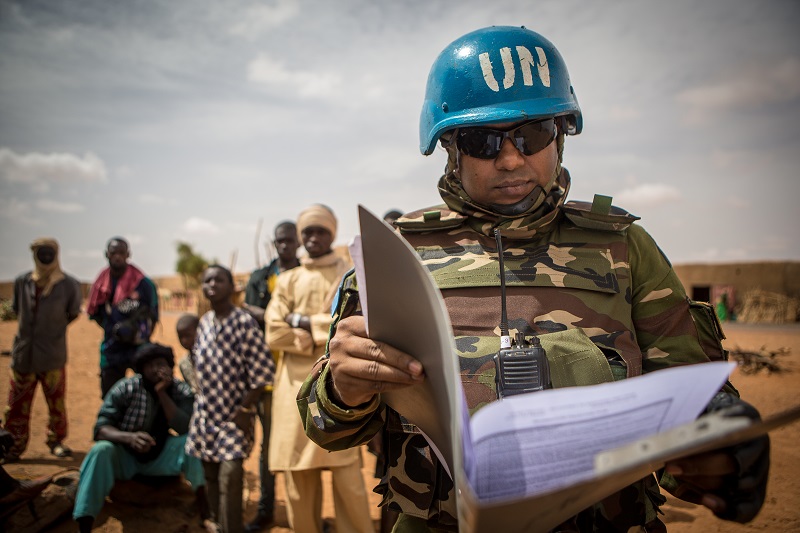
UN Photo/Harandane Dicko Peacekeepers of the United Nations Multidimensional Integrated Stabilization Mission in Mali (MINUSMA) conduct operations to protect civilians (11 July 2017)
UN Peacekeeping Operations, Political Missions and Peacebuilding Offices
During 2017, the Council adopted decisions concerning the mandate of 11 peacekeeping operations (out of 17 that were in operation in 2017) and seven political missions and peacebuilding offices (out of 12 that were in operation in 2017), primarily extending their mandates.
By resolution 2350 (2017), the Council extended the mandate of the United Nations Stabilization Mission in Haiti (MINUSTAH) for a final period of six months until 15 October 2017, and decided to establish a follow-on peacekeeping mission, namely, the United Nations Mission for Justice Support in Haiti (MINUJUSTH). Moreover, the United Nations Operation in Côte d’Ivoire (UNOCI) completed its mandate on 30 June 2017 as noted by presidential statement S/PRST/2017/8. By resolution 2366 (2017), the Council decided to establish the United Nations Verification Mission in Colombia, which succeeded the United Nations Mission in Colombia, established in 2016.
Changes in mandate and in the authorized strength

Peacekeepers of the United Nations Stabilization Mission in the Democratic Republic of the Congo (MONUSCO) conduct a community engagement patrol (23 August 2017)
In 2017, several peacekeeping operations, political missions and peacebuilding offices underwent significant changes in their mandates. For details see the comprehensive Mandate Table of current peacekeeping and political missions.
In addition, in 2017, four peacekeeping operations underwent revisions of their respective authorized ceiling of troop and/or police strength.
Chart 19: Increase and decrease of troops and police in Peacekeeping missions in 2017
| Mission | Authorized Troops | Resolution | Authorized Police | Resolution |
|---|---|---|---|---|
| MONUSCO (Democratic Republic of the Congo) |
-3,600 military personnel -100 military observers and staff officers) (16,215 military personnel, 660 military observers and staff officers) |
S/RES/2348(2017) |
no change (391 police personnel, 1,050 personnel of formed police units) |
S/RES/2348(2017) |
| UNISFA (Abyei) |
-535 military personnel (4,791 military personnel) |
S/RES/2352(2017) |
no change (50 police personnel) |
S/RES/2352(2017) |
| UNAMID (Darfur, Sudan) |
-4450 military personnel (11,395 military personnel) |
S/RES/2363(2017) |
-515 police personnel (2,888 police personnel including individual police officers and members of formed police units) |
S/RES/2363(2017) |
| MINUSCA (Central African Republic) |
+900 military personnel (11,650 military personnel, including 480 Military Observers and Military Staff Officers) |
S/RES/2387(2017) |
no change (2,080 police personnel, including 400 Individual Police Officers, and 108 corrections officers) |
S/RES/2387(2017) |
Sanctions and other Committees and Working Groups
Committees and Working Groups met a cumulative number of 117 times in 2017, in both formal and informal formats, as well as in joint meetings. A total of 23 briefings to Member States were also conducted by sanctions and other Committees.
Chart 20: Number of meetings and briefings per Sanctions and other Committees and Working Groups in 2017
Individuals and entities on Security Council sanctions and restrictive measures lists
As of 31 December 2017, a total of 678 individuals and 385 entities were subject to United Nations targeted sanctions and restrictive measures such as assets freeze, travel ban and arms embargo. A consolidated list containing the names of the individuals and entities subject to United Nations targeted measures is also available on the Security Council Subsidiary Organs website. In 2017, 53 individuals and 19 entities were added to the list. The charts below illustrate the number of listed individuals and entities for each sanctions committee as well as those added this year. Information on each committee, including individuals and entities designated by the relevant committee and the applicable sanctions measures, as well as the procedures for the processing of listing and delisting requests can be found on the Security Council Subsidiary Organs website.
Chart 21 (a): Total number of individuals and entities listed in 2017
Chart 21 (b): Number of individuals and entities listed as of 31 December 2017
* Upon implementation of Security Council resolution 2231 (2015)
De-listings from Security Council Sanctions Committees’ Lists in 2017
In 2017, 15 individuals and four entities were removed (also referred to as “de-listed”) from the respective sanctions lists. De-listing requests in relation to the ISIL (Da’esh) and Al-Qaida Sanctions List are submitted directly to the ISIL (Da’esh) and Al-Qaida Sanctions Committee or the Office of the Ombudsperson. De-listing requests with respect to all other sanctions lists are submitted to the respective sanctions committees or through the Focal Point for De-listing in the Secretariat. Any Member State can propose the de-listing of an individual or an entity. The relevant committee then considers the proposal, often in consultation with the designating state, and makes a final decision on whether or not to de-list. Often those proposing de-listings are the state of citizenship or residence of a listed individual, the state of location or place of registration of a listed entity, the designating state itself, or a Council member.
Chart 22: Number of names removed (de-listings from Security Council Sanctions Committees) in 2017
Focal Point for De-listing and Office of the Ombudsperson
In addition to the Member States’ ability to de-list, two mechanisms have been established to strengthen the de-listing process: the Office of the Focal Point for De-listing and the Office of the Ombudsperson. Established in 2006, the Office of the Focal Point for De-listing has received a total of 90 requests to de-list individuals and/or entities. 84 of these requests have been processed by 31 December 2017 and six are pending. As a result of this process, a total of 17 individuals and 17 entities have been de-listed and 30 individuals and 26 entities remain on the list. The Office of the Ombudsperson, established to serve as the de-listing mechanism for the ISIL (Da’esh) and Al-Qaida Sanctions Committee, has received a total of 80 requests to de-list individuals and/or entities since 2009, of which 74 have been processed and two are pending. As a result, a total of 52 individuals and 29 entities have been de-listed and 17 listings remain.
Chart 23: Activities of the Office of the Focal Point for De-listing as of the end of 2017
Chart 24: Activities of the Office of the Ombudsperson as of the end of 2017
Mandate extensions of Security Council subsidiary bodies
The chart below shows the number of Council resolutions extending the mandate of subsidiary bodies of the Council by month over the last five years [For details, see Annex, Table VII].
Chart 25: Mandate renewal by month: 2013-2017


